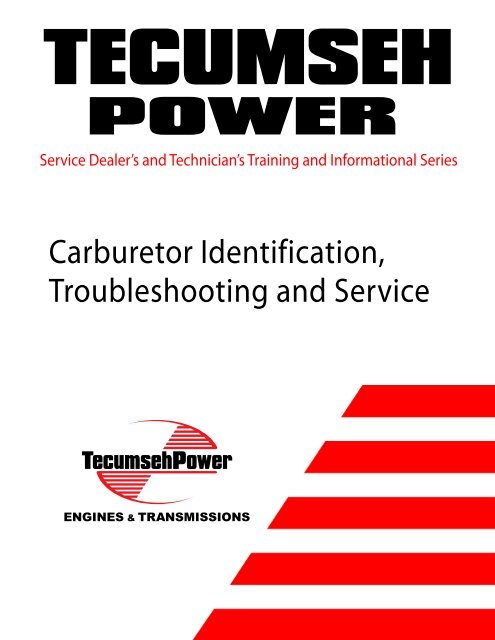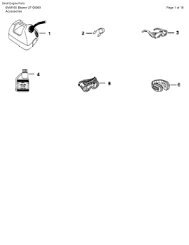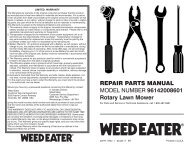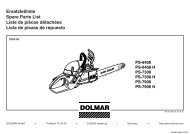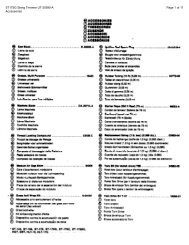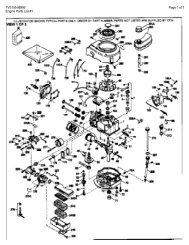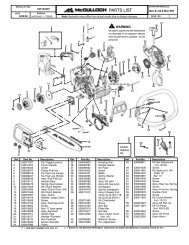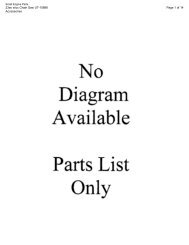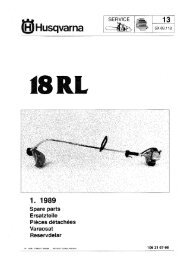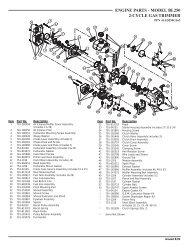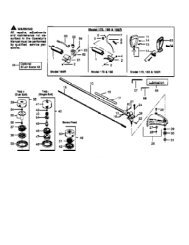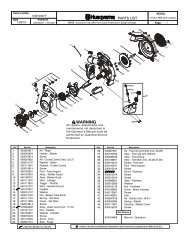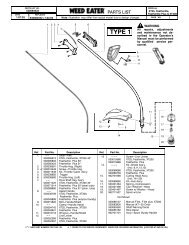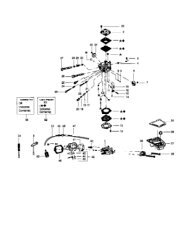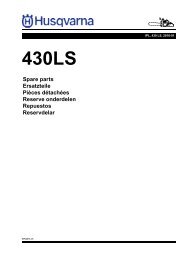Tecumseh Carburetor Identification, Troubleshooting, and Service
Tecumseh Carburetor Identification, Troubleshooting, and Service
Tecumseh Carburetor Identification, Troubleshooting, and Service
You also want an ePaper? Increase the reach of your titles
YUMPU automatically turns print PDFs into web optimized ePapers that Google loves.
TECUMSEHPOWER<strong>Service</strong> Dealer’s <strong>and</strong> Technician’s Training <strong>and</strong> Informational Series<strong>Carburetor</strong> <strong>Identification</strong>,<strong>Troubleshooting</strong> <strong>and</strong> <strong>Service</strong><strong>Tecumseh</strong>PowerENGINES & TRANSMISSIONS
Table of ContentsIntroduction . . . . . . . . . . . . . . . . . . . . . . . . . . . . . . . . . . 1Engine <strong>Troubleshooting</strong> . . . . . . . . . . . . . . . . . . . . . . . . . . . . 1Fuel Recommendations. . . . . . . . . . . . . . . . . . . . . . . . . . . . 2Storage . . . . . . . . . . . . . . . . . . . . . . . . . . . . . . . . . . . . 2High Altitude Jet for Emissionized <strong>Carburetor</strong>s . . . . . . . . . . . . . . . . 3High Altitude <strong>Carburetor</strong> Kits for Fixed Main <strong>Carburetor</strong>s. . . . . . . . . . . 4Throttle Control Brackets, Governors, <strong>and</strong> RPM Adjustments . . . . . . . . 5How to Identify a <strong>Tecumseh</strong>Power <strong>Carburetor</strong> . . . . . . . . . . . . . 5 - 10Non-<strong>Tecumseh</strong>Power <strong>Carburetor</strong>s . . . . . . . . . . . . . . . . . . . . . 10Diaphragm <strong>Carburetor</strong>s . . . . . . . . . . . . . . . . . . . . . . . . . 10 - 11<strong>Carburetor</strong> Cleaning Series 8 - 11 . . . . . . . . . . . . . . . . . . . 12 - 16Emission <strong>Carburetor</strong>s . . . . . . . . . . . . . . . . . . . . . . . . . . . . 17Pre-Sets <strong>and</strong> Adjustments (Non-Emission) . . . . . . . . . . . . . . . 18 - 20<strong>Troubleshooting</strong> Carburetion Chart . . . . . . . . . . . . . . . . . . . 21 - 22<strong>Troubleshooting</strong> <strong>Tecumseh</strong>Power <strong>Carburetor</strong>s. . . . . . . . . . . . . . . .. 23 .<strong>Troubleshooting</strong> Carburetion TC Series Chart . . . . . . . . . . . . . 24 - 25<strong>Troubleshooting</strong> Walbro <strong>and</strong> Tillotson . . . . . . . . . . . . . . . . . . . . 26Metering System . . . . . . . . . . . . . . . . . . . . . . . . . . . . . . . 26<strong>Service</strong> <strong>Carburetor</strong> Information . . . . . . . . . . . . . . . . . . . . . 27 - 28Using the Computer Parts Look Up System. . . . . . . . . . . . . . . . . 29Float Adjustment Procedure . . . . . . . . . . . . . . . . . . . . . . . . . 29<strong>Carburetor</strong> <strong>Service</strong> Tips. . . . . . . . . . . . . . . . . . . . . . . . . 30 - 33Primer Bulb <strong>Service</strong> . . . . . . . . . . . . . . . . . . . . . . . . . . . . . 34Fuel Filters . . . . . . . . . . . . . . . . . . . . . . . . . . . . . . . . . . 35Internal Atmospheric Vent Passage . . . . . . . . . . . . . . . . . . . . . 35Failure Analysis . . . . . . . . . . . . . . . . . . . . . . . . . . . . . 36 - 38Copyright © 20 02 by Tecumse h Power CompanyAll rights reserved. No part of this book may be reproduced or transmitted, in any form or b y any means, electronic ormechanical, including p hotocopying, recording or by any informa tion storage an d retrieval system, without permission inwriting from <strong>Tecumseh</strong> Power Comp any.I
INTRODUCTIONThis troubleshooting book is designed as a quick reference for carburetion problems <strong>and</strong> an aid in identifying failures<strong>and</strong> their possible causes. It also directs the user to other publications <strong>and</strong> printed material that assist in properlyresolving problems or making adjustments not related to carburetion but could affect carburetion.Listed below are some basic DO’S <strong>and</strong> DON’TS to be followed when making carburetor repairs.PLEASE DO:DO NOT:Follow all instructions carefully.Use new service replacement screws (650506 Torx 8) for the choke <strong>and</strong> throttle shutters (screws are treatedwith a dry-type adhesive to secure them in place).Use <strong>Tecumseh</strong>Power float tool 670377 or an 11/64 drill bit to set the proper float height. Remove the bowlgasket <strong>and</strong> measure from the casting surface. The gasket should be replaced or poor starting may result.Use only genuine <strong>Tecumseh</strong>Power service parts.Remove all welch plugs, o-rings <strong>and</strong> non-metallic main nozzles before cleaning carburetor in cleaner.Use drill bits to clean passages.Enlarge passages.Soak carburetor in a cleaner over 30 minutes.Reuse original choke <strong>and</strong> throttle shutter screws.Interchange bowl nuts.Reuse gaskets <strong>and</strong> “O” rings.ENGINE TROUBLESHOOTINGWhen troubleshooting a carburetor, other areas such as valves, fuel tank venting or gaskets should not beoverlooked. The carburetor is dependent on the proper operation of the engine to do its job. The first step introubleshooting is to determine if you have a carburetor or an engine problem.In order for the engine to operate properly, the following items need to be checked first:1. Make sure there is a sufficient amount of clean, fresh fuel in the tank.2. Check spark plug for proper reach, gap <strong>and</strong> condition. Replace, if needed, or in question. Perform anignition test using spark tester part number 670366 to assure that you have a crisp spark.NOTEOn older point ignitions models check for proper ignition timing according to the Technician's h<strong>and</strong>book.3. Check for fuel flow restrictions into the carburetor. Deteriorated fuel line, <strong>and</strong> fuel cap venting are some ofthe more common restrictions. <strong>Tecumseh</strong>Power uses a stainless steel 75 micron filter screen moldedinto most tanks. It is extremely rare for this area to become restricted <strong>and</strong> should be checked last.4. Check compression by first disconnecting the spark plug lead <strong>and</strong> ground it to prevent start-up. Next, turnthe engine over by h<strong>and</strong>. A definite resistance should be noticed on the compression stroke. Using acylinder leak down tester is also possible.After these basic checks have been performed <strong>and</strong> you are satisfied with the engine's condition, attempt to start it. If itdoes not start, remove the spark plug <strong>and</strong> check its condition. If it is dry, you can assume there is a problem with thecarburetor or the fuel system. Continue by troubleshooting the carburetor.1
FUEL RECOMMENDATIONSFUEL<strong>Tecumseh</strong>Power strongly recommends the use of fresh clean unleaded regular gasoline in all engines. Unleadedgasoline burns cleaner, extends engine life <strong>and</strong> promotes better starting by reducing build-up of combustion chamberdeposits. Reformulated fuels containing no more than 10% Ethanol, 15% MTBE, 15% ETBE or premium gasoline canbe used if unleaded regular gasoline is not available. Leaded fuel may be used in countries where unleaded fuel is notavailable. NEVER USE FUEL CONTAINING METHANOL.STORAGEIF THE ENGINE IS TO BE UNUSED FOR 30 DAYS OR MOREWARNING Gasoline (Fuel) vapors are highly flammable <strong>and</strong> can explode. Fuel vapors can spread <strong>and</strong> beignited by a spark or flame many feet away from the engine. To prevent injury or death from fuelfires, follow these instructions:• Never store the engine with fuel in the fuel tank inside a building with potential sources of ignition such as hot water<strong>and</strong> space heaters, clothes dryer, electric motors, etc.Gasoline can become unstable in less than 30 days <strong>and</strong> form deposits that can impede proper fuel flow <strong>and</strong> engineoperation. To prevent deposits from forming, all gasoline must be removed from the fuel tank <strong>and</strong> the carburetor. Anacceptable alternative to removing all gasoline is adding a fuel stabilizer such as <strong>Tecumseh</strong>Power Ultra-Fresh partnumber 730245 to the gasoline. Fuel stabilizer should be added to the fuel tank or storage container. Always follow themix ratio found on the stabilizer container. Run the engine at least 10 minutes after adding the stabilizer to allow it toreach the carburetor.Draining the Fuel SystemWARNINGCAUTIONDrain the fuel into an approved container outdoors, <strong>and</strong> away from any open flame or combustionsource. Be sure the engine is cool.NOTEIf gasohol has been used, put a small amount of unleaded gasoline into fuel tank <strong>and</strong> repeat preceding instructions,then run engine until fuel is used up.Oil Cylinder BoreDo not attempt to pour fuel from engine or siphon fuel by mouth. Empty fuel tank by using acommercially available suction device designed for use with gasoline. Then run the engine untilany remaining fuel is consumed. Doing so may result in death or serious injury.1. Remove the spark plug wire from the spark plug. NOTE: Always ground the plug wire when disconnected.Pull the starter h<strong>and</strong>le slowly until resistance is felt from compression pressure, then stop. Slowly releasestarter tension to prevent the engine from reversing due to compression pressure.2. Remove the spark plug, squirt 1/2 ounce (15 ml.) of clean engine oil into the spark plug hole.3. Cover the spark plug hole with a shop towel <strong>and</strong> crank the engine over slowly, several times.4. Replace the spark plug <strong>and</strong> tighten. Pull the starter h<strong>and</strong>le as performed in step #1. The piston positionblocks the cylinder ports on 2 cycle engines or closes the valves on 4 cycle engines, preventing air fromentering <strong>and</strong> oil from leaving the cylinder bore during storage.5. Re-connect the spark plug wire on the spark plug.2
HIGH ALTITUDE JETFOR EMISSIONIZED CARBURETORSThe following list of altitude compensation jets is being provided for use with emission grade carburetors atelevations between 6,000 <strong>and</strong> 11,000 feet (1,824 - 3,344 meters).This list applies only to engines which are identified as compliant with CARB (California Air Resource Board) or EPAUS Environmental Protection Agency) regulations.To determine the proper jet for your carburetor, simply locate the number stamped into the original bowl nut. Thenuse the chart below to identify <strong>and</strong> install the proper jet.NOTE: Installation of altitude compensation jets is NOT WARRANTYSTANDARD JET SERVICE HIGH ALT. JET SERVICENUMBER NUMBER USE BETWEEN 6,000 TO 11,000 FT NUMBER(1,824 TO 3,455 M)148 640181 203 640206152 640011 183 640114157 640032 169 640087158 640008 175 640062162 640024 149 640185166 640015 158 640008176 640059 170 640089181 640106 167 640188183 640114 184 640128184 640128 206 640209188 640170 163 640187190 640163 152 640011191 640162 158 640008202 640184 205 640186205 640208 203 640206206 640209 148 640181207 640210 206 6402093
HIGH ALTITUDE CARBURETOR KITSFOR FIXED MAIN CARBURETORSNOTEThis list applies only to products built prior to emissions regulation. Engines which are identified as compliant withCARB (California Air Resources Board) or EPA (US Environmental Protection Agency) regulations can NOT bechanged from their factory setting unless specifically authorized.Engines built to O.E.M. specifications may experience starting <strong>and</strong> operating problems when used in areas where thealtitude is 4,000 feet (1220 meters) above sea level or higher. A leaner fuel/air mixture is desirable at higher elevationsto sustain good engine startability <strong>and</strong> operating characteristics. Engines built with adjustable idle <strong>and</strong> main circuitcarburetors can be adjusted to optimize performance.The following will assist you in selecting the correct high altitude/leaner jetted bowl nut for engines equipped with fixedmain or dual system carburetors. Order parts from your Authorized <strong>Tecumseh</strong>Power Distributor or Dealer.4 CYCLESTANDARD BOWL/NUTENGINE STAMPED Over 4,000 Ft.TVS90-120/ECV90,100/TNT100 64, 65, 75, 79, 103,-108, 126, 127, 137 632455TVS90-120 / OHH50 / 55 158, 161, 164, 165, 166, 171, 172, 177 632737TVS90 -120, OVRM40-60 124, 125,133, 135, 136 631026OVM & OVXL120, OHV11-13 (Formula) 120, 141 632239Dellorto 69 633017VLV40, 50, 55, 60 Jet 632648VLV40, 50, 55, 60 Nozzle 632638TVM170-195 83, 132 632239TVM220 109, 131 631973OHV15 - Walbro LMK26 Jet 6326882 CYCLEAH/AV520 & 600, HSK600 101 632368TVS/TVXL840 L118, L119 632463HSK840, 845, 850/HXL840 124, 125 631026TC200/TC300 Tillotson carburetor only. Jet 632940TC200/TC300 Tillotson HU112 <strong>and</strong> HU114 Jet N/ADo not install leaner jetted bowl nuts on engines used below four thous<strong>and</strong> feet as starting <strong>and</strong> operating problems willoccur. DOING SO WILL VOID THE ENGINE WARRANTY.4
THROTTLE CONTROL BRACKETS,GOVERNORS AND RPM ADJUSTMENTSBefore adjusting any mixture screws, reset the screws to the recommended carburetor presets. Check for propergovernor adjustments as outlined in the appropriate Technician's H<strong>and</strong>book. Identify the locations of your high speed<strong>and</strong> low speed RPM adjustment screws. Check to make sure that the throttle control brackets are adjusted properly toallow for full choke. Always make sure that normal maintenance procedures (ie., oil, fuel, air cleaner, etc.) have beenchecked. Consult microfiche card #30, the computer parts look up system or <strong>Service</strong> Bulletin #107 for C.P.S.C.specifications to determine the proper RPM settings. Start the engine, allow it to warm up, the carburetor can then beadjusted for optimum performance by using the information outlined in this book. Now the low <strong>and</strong> high speed screwscan be adjusted to the recommended RPM's.HOW TO IDENTIFY A <strong>Tecumseh</strong>Power CARBURETOR<strong>Tecumseh</strong>Power has a variety of carburetors. To help identify these carburetors here are some simple procedures tofollow.DUAL SYSTEM CARBURETORSThe easiest way to identify the dual system carburetor isby the presence of a large primer bulb located on theside of the carburetor. The absence of adjustmentneedles help to identify the carb as well. The dualsystem carburetor is used on 4-cycle vertical crankshaftrotary mower engines.SERIES 1 CARBURETORSSeries 1 carburetors come in a variety of styles. Theyare used on both 2 <strong>and</strong> 4-cycle vertical <strong>and</strong> horizontalshaft engines in the 2 through 7 h.p. range. It is a floatstyle carburetor with a smaller venturi than the Series 3<strong>and</strong> 4 carburetors. Some will have an adjustable idle<strong>and</strong> main <strong>and</strong> others will have a fixed main with anadjustable idle. There are also some fixed speedapplications that will only have a fixed main system <strong>and</strong>the idle system will not be drilled.SERIES 1 EMISSIONThis carburetor is similar to the st<strong>and</strong>ard Series 1carburetor. The emission equivalent has a fixed idle <strong>and</strong>main. The idle restrictor jet will be capped to preventaccess unless the cap is removed. The fixed main jet ispart of the bowl nut. A ball plug is visible from the bottom,which seals the passage. This carburetor also has aserviceable main nozzle emulsion tube.5
HOW TO IDENTIFY A <strong>Tecumseh</strong>Power CARBURETOR(CONTINUED)SERIES 2 CARBURETORSSeries 2 carburetors were used on outboard engines.This carburetor is the same as the Series 1 with theexception of the remote adjustable idle mixture screw,<strong>and</strong> a built in fuel pump.Series 2 carburetors have a built-in fuel pump consistingof a fuel pump element which inflates <strong>and</strong> deflates withcrankcase pulsations which opens <strong>and</strong> closes two flapvalves in the fuel pump, thereby pumping fuel from aremote tank to the carburetor float bowl.When replacing the fuel pump element, install with theoslot opening at a 45 angle as illustrated. Installation inany other position will damage the diaphragm.SERIES 3 & SERIES 4 CARBURETORSSeries 3 <strong>and</strong> 4 carburetors are generally used on 8through 12.5 horsepower 4-cycle engines. The venturisize of these carburetors are larger than Series 1 <strong>and</strong>Dual System <strong>Carburetor</strong>s. The quickest way to identifythese carburetors is by the presence of bosses on eachside of the idle mixture screw.SERIES 3 & SERIES 4 EMISSIONThis carburetor is similar to the st<strong>and</strong>ard Series 3 & 4carburetor with a few subtle differences. The emissionequivalent has a fixed idle <strong>and</strong> main. The idle restrictorjet will be capped to prevent access unless the cap isremoved. The fixed main jet is part of the bowl nut. A ballplug is visible from the bottom, which seals the passage.This carburetor also has a serviceable main nozzleemulsion tube.FIXED IDLEFIXED MAIN6
HOW TO IDENTIFY A <strong>Tecumseh</strong>Power CARBURETOR(CONTINUED)To determine whether the carburetor is a Series 3 orSeries 4, look at the throttle or choke end of thecarburetor.Series 3 will have one screw on the throttle <strong>and</strong> chokeplates.The Series 4 will have two screws on the throttle <strong>and</strong>choke plates.SERIES 3 SERIES 4VECTOR CARBURETORSThe Vector carburetor is a float feed, nonadjustablecarburetor, with a one piece extruded aluminum body.The float bowl, float, nozzle, <strong>and</strong> venturi are nonmetallic,which eliminates the corrosion <strong>and</strong> varnishing problemsassociated with similar metallic parts. Common serviceareas of the carburetor are contained in the fuel bowl,which include the float, needle, seat <strong>and</strong> main nozzleemulsion tube. All of these parts can be serviced withoutremoving the carburetor body from the engine.NOTEIf the unit was run with poor filter maintenance theventuri should be removed <strong>and</strong> the air bleeds cleanedwith solvent.SERIES 6 CARBURETORS - 4 CYCLESeries 6 carburetors are used on 2 <strong>and</strong> 4-cycle engines.They have a larger venturi than the dual systemcarburetor <strong>and</strong> use a simple fixed idle system. Series 6carburetors used on both vertical <strong>and</strong> horizontalapplications are nonadjustable. The 4-cycle versionpictured has a stepped primer bulb.7
HOW TO IDENTIFY A <strong>Tecumseh</strong>Power CARBURETOR(CONTINUED)SERIES 6 CARBURETORS - 2-CYCLESeries 6 carburetors used on TVS/TVXL840 enginesare similar in appearance <strong>and</strong> operation to thecarburetors used on 4-cycle engines with the followingdifferences:1. The bowl nut is left-h<strong>and</strong> thread. This bowl nutis identified by an "L" stamped on the nut <strong>and</strong>the international left thread notches across thepoints.2. A dampening spring is installed on the floathinge pin to reduce erratic float travel.3. The two mounting bosses extend out from thecarburetor body.CUTLINESERIES 7 CARBURETORS (EMISSION)The Series 7 carburetor is an emissions gradecarburetor used on medium frame vertical shaftoverhead valve engines. It has a non-metallic bowl <strong>and</strong>a snap-on bowl retainer to connect it to the carburetorbody. This model has a fixed main jet <strong>and</strong> a fixed idle jet;both are located in the carburetor bowl. The float bowl,float, nozzle, <strong>and</strong> venturi are non-metallic, whicheliminates the corrosion <strong>and</strong> varnishing problemsassociated with similar metallic parts. Common serviceareas of the carburetor are contained in the fuel bowl,which include the float, needle, seat <strong>and</strong> main nozzleemulsion tube. All of these parts can be serviced withoutremoving the carburetor body from the engine.SERIES 8 CARBURETOR (EMISSION)The Series 8 carburetor has both a fixed main <strong>and</strong> idlecircuit. The fixed idle system is achieved by a restrictorjet that meters the fuel for the idle circuit. The idlerestrictor jet will be capped to prevent access unless thecap is removed. The fixed main jet is part of the bowlnut. A ball plug is visible from the bottom, which sealsthe passage. This carburetor also has a serviceablemain nozzle emulsion tube. It also has a stepped primerbulb.8
HOW TO IDENTIFY A <strong>Tecumseh</strong>Power CARBURETOR(CONTINUED)SERIES 9 CARBURETORThe Series 9 carburetor is an emissions carburetor thatuses the same carburetor body as the Series 8 but with asimple fixed idle system, identical to the one used on theSeries 6 carburetor. It has the idle discharge port locatedat the 7 o'clock position on the throttle end of thecarburetor. Identify this carburetor by the stepped primerbulb, the presence of a non-drilled idle mixing well <strong>and</strong> aserviceable main nozzle emulsion tube.SERIES 10 (EMISSION)The Series 10 carburetor is identical to the Series 8carburetor with the addition of a choke. To assist in coldweather starts. It has a fixed idle <strong>and</strong> main. The idlerestrictor jet will be capped to prevent access unless thecap is removed. The fixed main jet is part of the bowl nut.A ball plug is visible from the bottom, which seals thepassage. This carburetor also has a serviceable mainnozzle emulsion tube. It also has a stepped primer bulbto assist in starting.SERIES 11This carburetor adds a fuel chamber, built into thecarburetor body, that feeds fuel into the venturi duringthe initial warm up period. This patented featureeliminates, hunting, surging <strong>and</strong> false starts inherent toemissions engines. However external identification ofthe Series “11” carburetor has been a challenge. Tomake this ID simple, the Series “11” carburetor idlerestrictor cap will be black, <strong>and</strong> all others will be gray. Thepart number for the black cap is 640200 <strong>and</strong> the gray is640053.SERIES 11 BRIDGEDThis carburetor is identical to the Series “11” with theexception of the center leg. A non-metallic jet is pressedinto the center leg to allow additional fuel into the main jetfor applications that require this fuel to enhance runperformanceCAPPED JETNONMETALLIC JETCARBURETOR CLEANING - SERIES 11 <strong>and</strong> SERIES11 BRIDGEDWith the additional fuel well welch plug removed, youcan see the small plastic metering jet, which can bedistorted if left to soak in a carb dip tank. Currently, thismetering jet is not a serviceable part. Our position hasbeen to soak a carburetor no more than ½ hour but theexception is the Series 11 carburetor. To be safe, serviceall <strong>Tecumseh</strong>Power carburetors with <strong>Carburetor</strong> Spray# 696410 along with a .012” (.304 mm) gauge wire.STANDARD 11BRIDGEDSERIES 119
NON-<strong>Tecumseh</strong>Power CARBURETORSDELLORTO CARBURETORThe Dellorto carburetor is similar to the dual systemcarburetor. It has no adjustments <strong>and</strong> has a primer assiststart. It has a noncorrosive float <strong>and</strong> the needle is vitontipped, eliminating the viton seat found in the dual systemcarburetor. The angle of the fuel inlet is adjustable <strong>and</strong>attached to the carburetor body with a banjo bolt. Thiscarburetor is used on some TVS rotary lawnmowerengines.WALBRO LMK CARBURETORThe Walbro LMK has a large venturi <strong>and</strong> a fixed main withan adjustable idle. It is used on some OHV engines. Thiscarburetor has a noncorrosive float <strong>and</strong> a viton tippedneedle. It also has a nonmetallic choke shaft. It is easilyidentified by the Walbro name on the carburetor bodynext to the idle adjustment screw.WALBRO WHG CARBURETORThe WHG, used on OH cast iron engines, can be built as afully adjustable, single adjust or nonadjustablecarburetor. It has a large venturi. Its most recognizablefeature is the large square mounting surface on the chokeend of the carburetor.DIAPHRAGM CARBURETORSDIAPHRAGM CARBURETORSThe diaphragm carburetors are unique. Thesecarburetors can be operated at a more severe anglethan float style carburetors. They still require that thefuel supply be located in a position that allows it to begravity fed. Its most distinctive feature is the lack of afuel bowl.10
DIAPHRAGM CARBURETORS(CONTINUED)WTA WALBRO CARBURETORThe WTA carburetor has a rubber-type diaphragm,which is exposed to intake pressure on one side <strong>and</strong> toatmospheric pressure on the other. The WTA is used onTC200 <strong>and</strong> 300 engines. There are two adjustmentscrews. They are the idle mixture screw <strong>and</strong> the idleRPM screw. The WTA has a choke <strong>and</strong> an all metal fuelinlet fitting. The Walbro name is molded onto the pumpcover.WT WALBRO CARBURETORThe WT Walbro carburetor is used on the TC-II styleengine. It is similar to the WTA carburetor but its reverseimage. The WT has no choke lever <strong>and</strong> has acombination plastic <strong>and</strong> metal fuel inlet fitting.TILLOTSON HU CARBURETORThe Tillotson HU carburetor is the reverse image of theWTA Walbro carburetor. It is used on the TC-II. TheTillotson HU has a replaceable main <strong>and</strong> Tillotson isvisible on the pump cover.<strong>Tecumseh</strong>Power TC CARBURETORThis carburetor has a fixed idle <strong>and</strong> main which meetsthe emissions st<strong>and</strong>ards for two cycle engines. The mainjet is serviceable <strong>and</strong> can be accessed by removing theplastic cap. The jet is removed for cleaning purposesonly, <strong>and</strong> must be covered after servicing to maintaincompliance with emissions regulations.11
CARBURETOR CLEANING SERIES 8 - 111. Remove bowl <strong>and</strong> push the float hinge pin out withcarb tool part # 670377. The float cannot be rotatedupward.2. Remove the seat with the carb tool.3. Remove the emulsion tube by gently inserting thecarb tool. Rotate the hook end until you locate the airbleed passage. Then with hook in place, pull the tubeout.4. Remember there are two "O" rings on the emulsiontube. You may have to go into the center leg a secondtime to remove the upper second "O" ring.12
CARBURETOR CLEANING SERIES 8 - 11(CONTINUED)SMALL CHISELPIERCE PLUG WITHTIP5. Remove the extended prime well welch plug with asharpened chisel. When piercing through theextended prime well welch plug, pound close to thered primer bulb side as not to mar the casting.PRY OUT PLUGDO NOT ALLOWCHISEL POINTTOSTRIKECARBURETORBODY OR CHANNELREDUCERSMALL CHISELWELCH PLUG TO BEREMOVEDABOUT 1/8” WIDE6. Clean the extended prime well w/.012" tag wire <strong>and</strong>carb spray.7. Remove the idle prime well welch plug. Using asharpened chisel or punch. Clean the progressionholes <strong>and</strong> the idle air bleed hole using tag wire <strong>and</strong>carb spray. If damage occurs in progression holes,replace with a new carburetor.8. Remove the idle restrictor cap <strong>and</strong> clean the idle jetwith tag wire <strong>and</strong> carb spray.13
CARBURETOR CLEANING SERIES 8 - 11(CONTINUED)9. Clean the idle circuit fuel pick-up located in thecenter leg using tag wire.10. The Series 11 bridged carburetor has anadditional idle circuit fuel pick-up jet on the side ofthe center leg. Clean this with .012" (.3 mm) tagwire.11. Clean main jet (bowl nut) with tag wire. Rememberthere are three drilled passages. The fuel pick-up,the main jet <strong>and</strong> the idle delivery hole.12. Spray all cavities with <strong>Tecumseh</strong>Power carburetorspray part # 696410.14
CARBURETOR CLEANING SERIES 8 - 11(CONTINUED)17. Adjust the float if necessary by bending the metaltang.18. Bring the float/needle assembly down into position,then insert the float hinge pin.Always remember the open end of the needleclip on a <strong>Tecumseh</strong>Power carburetor, faces outtoward the air cleaner side.19. Install a new float bowl, bowl "O" ring, <strong>and</strong> the bowlnut with a new bowl nut gasket.16
PRE-SETS AND ADJUSTMENTS(NON-EMISSION)<strong>Tecumseh</strong>Power CARBURETORSPre-sets <strong>and</strong> AdjustmentsSERIES 1Engine Model Main Pre-set Idle Pre-setAll models with float -typecarburetors 1-1/2 turn 1 turnAll models with diaphragm-typecarburetors 1 turn 1 turnMAIN AND IDLE PRE-SETSTurn both main <strong>and</strong> idle mixture adjusting screws in(clockwise) finger tight. (CAUTION: Over-tightening willdamage the taper portion of the needle.) Then back thescrews out (counterclockwise) to the pre-set figure in thechart shown above.NOTESome carburetors have fixed main jets. The absence ofthe adjusting screw indicates a fixed jet <strong>and</strong> noadjustment is necessary.IDLE MIXTURESCREWIDLE MIXTURESCREWMAIN MIXTURESCREWSERIES III, IVMAIN MIXTURESCREWDIAPHRAGM“F”DESIGNATIONNOTESeries1 carburetors are built with one of two differentstyles of adjustment needle for the idle. The long needleis used on air adjust systems. The short needle on fueladjust systems. The adjustments are the same for bothsystems, however, the drop off point may not be asnoticeable.FINAL ADJUSTMENTS (MAIN)Start the engine <strong>and</strong> allow it to warm up to normaloperating temperature (3-5 minutes). Set the speedcontrol to HIGH or FAST position, then turn the mainmixture adjustment screw in (clockwise) slowly until theengine begins to run erratic. Note the position of thescrew. Now, turn the screw out (counterclockwise) untilthe engine begins to run erratic. Turn the screw in(clockwise) midway between these two positions. Thiswill be the best setting.Set the speed control to the IDLE or SLOW positioncheck for proper IDLE or LOW speed RPM <strong>and</strong> adjustthe idle mixture screw in the same manner as the mainmixture screw.If further adjustment is required, the main adjustmentshould be made with the engine under a loadedcondition.18FUEL ADJUSTAIR ADJUSTIDLE MIXTURESCREWMAIN MIXTURE SCREWCAUTION Never operate the engine withcovers or guards removed. Rotatingparts can cause severe injury. Keep h<strong>and</strong>s, feet, hair,jewelry <strong>and</strong> clothing away from all moving parts.Engage the driven equipment (cutter deck, impeller, etc.)so as to put the engine under a load condition.If the engine stops or hesitates while engaging the load(lean), turn the main mixture adjusting screw out(counterclockwise) 1/8 turn at a time, testing eachsetting with the equipment under load, until this conditionis corrected.If the engine smokes excessively (rich), turn the mainadjusting screw in (clockwise), 1/8 turn at a time, testingeach setting with the equipment under load, until thiscondition is corrected.After the main mixture is set, move the speed control tothe IDLE or SLOW position. If the engine does not idlesmoothly, turn the idle mixture screw 1/8 turn either in(clockwise) or out (counterclockwise) until engine idlessmoothly.Recheck your HIGH <strong>and</strong> LOW RPM settings <strong>and</strong> adjustas necessary.
PRE-SETS AND ADJUSTMENTS(CONTINUED)RPM ADJUSTMENTSNow, the LOW <strong>and</strong> HIGH speed screws can be adjusted to the recommended RPM's. First identify the location of bothHIGH <strong>and</strong> LOW speed RPM adjustment screws, then identify the recommended HIGH <strong>and</strong> LOW RPM settingsaccording to microfiche card 30, the computer parts look-up system or <strong>Service</strong> Bulletin #107 for rotary mowers.GOVERNED / NON-GOVERNED IDLEWith the engine running at the lowest speed set the governed idle at the designated RPM by bending the idle RPM tab.Next set the non-governed idle by pushing the bottom of the governor lever away from the control brackets, so thethrottle lever contacts the idle speed screw. Hold the lever in this position <strong>and</strong> turn the idle adjustment screw clockwiseto increase or counterclockwise to decrease engine idle speed. The setting on the carburetor screw should be set 600RPM below the tab or governed idle setting.WALBRO CARBURETORS 4 CYCLEPRE-SETS AND ADJUSTMENTS<strong>Carburetor</strong> Model No. Main Pre-set Idle Pre-setLMH 1-1/2 turn 1-1/2 turnWHG & LME 1-1/4 turn 1-1/4 turnLMK FIXED 1 turnMAIN AND IDLE PRE-SETSTurn both the main <strong>and</strong> idle mixture adjusting screws in(clockwise) finger tight. (CAUTION: Over -tightening willdamage the tapered portion of the needle.) Now backthe screws out (counterclockwise) to the pre-set figurein the chart shown above.NOTESome carburetors have fixed main jets. The absence ofthe adjusting screw indicates a fixed jet <strong>and</strong> noadjustment is necessary.FINAL ADJUSTMENTSStart the engine <strong>and</strong> allow it to warm up to normaloperating temperature (3-5 minutes). Set the speedcontrol to HIGH or FAST position, then turn the mainmixture adjustment screw in (clockwise) slowly until theengine begins to run erratic (lean). Note the position ofthe screw. Now turn the screw out (counterclockwise)until the engine begins to run erratic (rich). Turn thescrew in (clockwise) midway between these twopositions. This will be the best setting.IDLE MIXTURESCREWIDLE MIXTURESCREWMAIN MIXTURESCREWCARBURETORMODELNUMBERFIXED MAINSet the speed control to IDLE or SLOW position <strong>and</strong>adjust idle mixture screw in the same manner as themain mixture screw.Now the LOW <strong>and</strong> HIGH speed governor adjustmentscrews can be set to the recommended RPM's. Firstidentify the location of both HIGH <strong>and</strong> LOW speedgovernor adjustment screws, then identify therecommended HIGH <strong>and</strong> LOW RPM settings accordingto microfiche card 30.If further adjustment is required, the main adjustmentshould be made under a load condition.CAUTION Never operate the engine withcovers or guards removed. Rotatingparts can cause severe injury. Keep h<strong>and</strong>s, feet, hair,jewelry <strong>and</strong> clothing away from all moving parts.Engage the driven equipment (cutter deck, impeller,etc.) so as to put the engine under a loaded condition.IDLE MIXTURESCREWMAIN MIXTURESCREWIf the engine stops or hesitates while engaging the load(lean), turn the main mixture adjusting screw out(counterclockwise) 1/8 turn at a time, testing each settingwith the equipment under load until this condition iscorrected.If the engine smokes excessively (rich), turn the mainadjusting screws in (clockwise) 1/8 turn at a time, testingeach setting with the equipment under load, until thiscondition is corrected.After the main mixture is set, move speed control to theIDLE or SLOW position. If the engine does not idlesmoothly, turn the idle mixture screw 1/8 turn either in(clockwise) or out (counterclockwise) until engine idlessmoothly.Recheck your HIGH <strong>and</strong> LOW RPM settings <strong>and</strong> adjustas necessary.19
PRE-SETS AND ADJUSTMENTS(CONTINUED)WALBRO CARBURETORS 2-CYCLEPRE-SETS AND ADJUSTMENTS<strong>Carburetor</strong> Model No. Main Pre-set Idle Pre-setWTA & WT FIXED 1-1/4 turnsTILLOTSON CARBURETOR 2-CYCLEPRE-SETS AND ADJUSTMENTS<strong>Carburetor</strong> Model No. Main Pre-set Idle Pre-setHU FIXED 1-1/2 turnsIDLE SPEEDADJUSTIDLE MIXTURESCREWIDLE PRE-SETTurn idle mixture adjustment screw (clockwise) fingertight to closed position, then turn the screw(counterclockwise) according to the above chart. Thissetting will allow engine to be started so carburetor canbe fine tuned.TILLOTSON HUCARBURETORFINAL ADJUSTMENTIdle Mixture: Start the engine <strong>and</strong> let it reach its normaloperating temperature (3-5 minutes). Begin slowlyturning the idle mixture screw in (clockwise). As you turnit in (clockwise), the engine will begin to falter, this is thelean drop off point.IDLE SPEEDADJUSTIDLE MIXTURESCREWNOTEIf the RPM is greater than 2,400 stop the procedure <strong>and</strong>reduce idle RPM. Settings above 2,400 will cause fuelfrom the main jet to contribute to the idle mixture creatingan inaccurate idle mixture setting. Turn the needle outuntil the engine begins to falter. Note this position, this isthe rich drop-off. Your final needle setting is halfwaybetween the rich <strong>and</strong> the lean drop-off points. Once themixture is set, the idle speed needs to be adjusted. Setthe idle speed at the recommended RPM.WALBRO WTCARBURETORWALBRO CARBURETORS 4-CYCLE FIXED (WHG)(OH120 - 180)On occasions high altitude has affected the operation ofhigh <strong>and</strong> low speed performance. To correct thissituation use the following steps:1. Remove air cleaner assembly.2. Remove choke shaft assembly.3. Using an ice pick type tool with a small hook on theend, remove the brass cup plug out of the nozzle wellvent.NOTEDo not use a thread tap as chips may enter thecarburetor.IDLE AIR RESTRICTOR4. Reassemble choke shaft assembly.5. Reinstall air cleaner assembly.20
TROUBLESHOOTING CARBURETION<strong>Tecumseh</strong>Power CARBURETORSFLOAT AND DIAPHRAGMSTARTHard StartingFuel Leak at <strong>Carburetor</strong>Engine FloodsIDLEWill Not IdleRich IdleIdles with needle closedHunts - Erratic idleIdles fast - leanACCELERATEWill not accelerateOver rich accelerationHesitatesHIGH SPEEDLow powerWill not run at high speedHunts at high speedRuns with needle controlEngine OverspeedsFUEL SYSTEMImproper Priming Procedure • •Bad Bowl Gasket • • •Plugged Tank Filter or Vent • • • • • •Fuel Pick-up Restricted • • • • • • •Idle Port Restricted • • • • • • •Damaged Adjustment Needles • • • • • • • • • • •Incorrect Float Height • • • •Main Nozzle Restricted • • • • • •Dirty, Stuck, Needle <strong>and</strong> Seat • • • •EMISSIONFuel Inlet Plugged • • • • •• • • • • •“O” Ring Mission or DamagedEmulsion Tube21
TROUBLESHOOTING CARBURETION<strong>Tecumseh</strong>Power CARBURETORSFLOAT AND DIAPHRAGMSTARTHard StartingFuel Leak at <strong>Carburetor</strong>Engine FloodsIDLEWill not IdleRich IdleIdles with needle closedHunts - Erratic idleIdles fast - leanACCELERATEWill not accelerateOver rich accelerationHesitatesHIGH SPEEDLow powerWill not run at high speedHunts at high speedRuns with needle controlEngine OverspeedsAIR SYSTEMPlugged Air Filter • • • • • • •Leaky <strong>Carburetor</strong> Gaskets • • • •Throttle or Choke Shafts Worn • • • • • • • •Choke not functioning properly • •Plugged Atmospheric Vent •Air Bleed Restricted • • • • • • •Damaged or Leaky “O” Ring • • • • •DIAPHRAGM SYSTEMDamaged Diaphragm • • • • •Stuck or Dirty Ball Check • • • • • • •Diaphragm Upside Down • • • •22
TROUBLESHOOTING<strong>Tecumseh</strong>Power CARBURETORSUse the troubleshooting chart to determine the cause of aparticular carburetor problem. Once the problem isidentified, it will be necessary to select the proper correctiveaction.SECONDARY IDLEDISCHARGE(NOT OPERATING)IDLE MIXTUREMIXING WELLIDLEAIR BLEEDMAIN NOZZLEAIR BLEEDMost repairs will consist of one of the following items:IDLEADJUSTMENTSEAT1. At times it will be necessary to thoroughly clean thecarburetor. First remove all welch plugs, adjustmentscrews, "O" rings <strong>and</strong> the needle <strong>and</strong> seat. After soakingthe carburetor in a commercial cleaner for no longerthan 30 minutes, use compressed air or a soft tag wire toclean passages.IDLEADJUSTMENTSCREW2. If parts are worn or damaged, determine the extent of thedamage. Check to see if the repair be made by justreplacing parts or if the body of the carburetor is worn<strong>and</strong> in need of replacement.3. Always replace throttle <strong>and</strong> choke shutter screws withnew service screws (650506). New service screws havea dry adhesive on the threads. Replace all gaskets.IDLE SPEED ADJUSTMENTSCREWSERIES 7MIXING WELLIDLEAIR BLEEDIDLERESTRICTORIDLE/TRANSFERFUELPASSAGEIDLE PICK-UPMAIN JETATMOSPHERICVENT PASSAGESMAIN NOZZLEAIR BLEEDTHROTTLE SHAFTANDLEVERCHOKE SHAFT AND LEVERSPRINGMAIN JETDETENT REFERENCEMARK ON THROTTLESHUTTERTHROTTLE SHAFTRETURN SPRINGTHROTTLESHUTTERCHOKE SHUTTERMAIN NOZZLE*INLETFITTINGSCREENSERIES 8MIXING WELLIDLEAIR BLEEDIDLEMETERINGJETATMOSPHERICVENTMAIN NOZZLEAIR BLEEDIDLE ANDINTERMEDIATE*INLETFITTINGAIR BLEEDORIFICE*INLET SEATGASKETIDLE/TRANSFERFUELPASSAGE*IDLE MIXTUREADJUSTMENTSCREW AND“O” RING(If Present)*MAIN MIXTURE ADJUSTMENTSCREW AND “O” RING(If Present)WELCH PLUG (If Present)*MAIN NOZZLE CHECK BALL (If Present)*DIAPHRAGMGAKSET*INLET NEEDLESEAT ANDSPRINGASSEMBLY*DIAPHRAGMATMOSPHERICVENT HOLESERIES 9IDLE/TRANSFERFUELPASSAGEIDLEAIR BLEEDATMOSPHERICVENTMAIN NOZZLEAIR BLEED*NON-METALLIC ITEMS - CAN BE DAMAGED BY HARSHCARBURETOR CLEANERSIDLEFUEL PASSAGE23
TROUBLESHOOTING CARBURETIONTC SERIESSTARTHard StartingFuel Dripping From <strong>Carburetor</strong>IDLE (Low Speed)Floods Engine When Not RunningWill Not IdleRich IdleIdles With Needle ClosedErratic IdleLoads Up While Idling“L” Needle Needs Frequent AdjustmentWill Not AccelerateACCELERATION & DECELERATIONOver-rich AccelerationEngine Stops When Closing ThrottleHIGH SPEEDWill Not Run At W.O.T.Low PowerNot Rich Drop OffADJUSTMENTSLow • • • • • •High • • • • •FUEL SYSTEMPlugged Tank Filter or Vent • • • • • •Restricted Fuel Line • • • • •Dirt in Fuel Passage • • • • • •Loose, Damaged Fuel Line • • • • • •Leak in Pulse System• • •Restricted Pulse Channel • • • •Loose Pump Cover Screw • • • • •Defective Pump Diaphragm • • • • • •AIR SYSTEMPlugged Air Filter • • • • •Defective Manifold Gasket • • • • •Loose Carb. Mounting Bolts • • •Worn Throttle Shaft or Valve•Incorrect Throttle AssemblyLoose Throttle Valve ScrewThrottle Shaft Too TightBent Throttle LinkageDefective Throttle SpringBent Throttle Stop LeverChoke Not Functioning ProperlyWorn Choke Shaft or Valve•••••••24
TROUBLESHOOTING CARBURETIONTC SERIES(CONTINUED)STARTHard StartingFuel Dripping From <strong>Carburetor</strong>IDLE (Low Speed)Floods Engine When Not RunningWill Not IdleRich IdleIdles With Needle ClosedErratic IdleLoads Up While Idling“L” Needle Needs Frequent AdjustmentWill Not AccelerateACCELERATION & DECELERATIONOver-rich AccelerationEngine Stops When Closing ThrottleHIGH SPEEDWill Not Run At W.O.T.Low PowerNot Rich Drop OffMETERING SYSTEMLEVERWorn Lever•Set Too High • • • • • • •Set Too Low • • •Not Free • • • • • • •SPRINGDistorted • •Improperly Installed • •DIAPHRAGMLeaking (Air / Fuel) • • • • •Worn Button•Improper Assembly • • •Defective Gasket • • • •Loose Diaphragm Rivet• •Hole in Diaphragm • • • •Loose Cover Screws • • • • •INLET NEEDLE & SEATForeign Matter • • • • • • •Binding • • • • • • • • • •Worn Needle Body or Tip • • • • •NOZZLE CHECK VALVE • • • • • •25
SERVICE CARBURETOR INFORMATIONTo identify a carburetor for replacement on an engine, usethe model <strong>and</strong> specification number of the engine. If theengine model <strong>and</strong> specification number are not present forsome reason, there is a model <strong>and</strong> code date numberstamped on the body of every carburetor.ALTERNATE LOCATIONFOR MANUFACTURINGNUMBERManufacturing Number Month Year Work Day of Mo.162 C 2 R162C 2 RMANUFACTURINGNUMBERCARBURETORDATE CODEWith the model number, you will be able to find all of theinformation needed to repair or replace the carburetor. Inthe Master Parts Manual or the microfiche carburetorsection, locate the manufacturing to service number crossreference list. Find the service part number listed for thecarburetor. It will also list the page or grid where thecarburetor breakdown can be found.MFG. TO SERVICE NO.Mfg. <strong>Service</strong> Page Mfg. <strong>Service</strong>Model No. Part No. No. Model No. Part No.154 631176 68 215 631375155 631195 70 216 631286156 631182 68 217 631301157 631181 66 220 631297158 631185 66 221 631297159 631217 70 222 631299160 631186 66 223 631312161 631213 70 224 631290162 631211 68 225 631294163 631210 70 226 631298164 631196 70 227 631295165 631244 72 229 631311166 631244 72 229 631310167 631209 70 230 631310168 631241 68 231 631341169 631928 206 232 631349170 631215 70 233 631316171 631218 70 234 631313Std Code Description Std Code DescriptionPkg Part or Pkg Part orQty Number Supersedence Qty Number SupersedenceWhen referencing the carburetor in the price list, the originalcarburetor may be superseded to a service carburetor.Some <strong>Tecumseh</strong>Power service carburetors will not havethe fuel fitting. These carburetors can be identified by thedescription listed as SVC Carb NF, meaning servicecarburetor, no fitting. If this designation is not made in thelisting, the carburetor will have a fuel fitting.10 631183 WASHER 631785A SVC CARB NF10 631184 WASHER 631786 SERVICE CARB10 631190 O RING 631787 SERVICE CARB10 631191 WASHER 631788 4 USE 631788A631193 4 USE 631893 631788A SVC CARB NF631194 4 USE 631855 631789 4 USE 631789A631197 4 USE 631226 631789A SVC CARB NFUSE 631226A 631790 4 USE 631790AUSE 631564 631790A SVC CARB NF631198 4 USE 630978 631791 SERVICE CARB10 631201 CHECK VALVE 631792 4 USE 631972A10 631202 FUEL FITTING 631792A SVC CARB NF631205 4 USE 630898 631793 SERVICE CARB631207 4 USE 630932A 631794 4 USE 631794A631208 4 USE 631893 631794A SVC CARB NF631211 4 USE 631790 631795 4 USE 631795AUSE 631790A 631795A SVC CARB NF27
SERVICE CARBURETOR INFORMATION(CONTINUED)When the price list supersedes the originalcarburetor you are ordering to a servicecarburetor, you will need to identify the partsnot included on the service carburetor. Todetermine these parts, turn to Division 5,Section A in the Master Parts Manual or theappropriate microfiche card listed under"carburetor." The information can be foundunder the title "List of parts required to build acomplete carburetor from a st<strong>and</strong>ard servicecarburetor."The cross section shown below uses 631211as the original carburetor number. The pricelist supersedes that number to 631790A whichis a service carburetor. The items shownfollowing the number must be added to theservice carburetor to make it a completecarburetor. Parts may be used from theoriginal carburetor if they are in goodcondition. NEVER REUSE THE ORIGINALTHROTTLE AND CHOKE SHUTTERSCREWS.NOTESince the mid 1980's <strong>Tecumseh</strong>Power hasdiscontinued the practice of establishing newservice carburetors.LIST OF PARTS REQUIRED TO BUILD A COMPLETE CARBURETOR FROM A STANDARD SERVICE CARBURETORTHIS LISTING REQUIRED ONLY WHEN ORIGINAL CARBURETOR TO BE REPLACED IS NOT AVAILABLE.NOTE WELL:IN ADDITION TO PARTS LISTED BELOW, ALL WILL REQUIRE:1 EACH 650506 CHOKE SHUTTER SCREW1 EACH 650417 IDLE REGULATING SCREW1 EACH 630766 IDLE REGULATING SCREW SPRINGSTANDARD THROTTLE THROTTLE CHOKE CHOKE CHOKE DETENTORIGINAL CARB SERVICE SHAFT RETURN SHAFT CHOKE RETURN DETENT SPRINGPART NO. MFG. NO. CARB NO. ASSY. SPRING ASSY. SHUTTER SPRING SPRING SCREW28631177 148 631800A 31384 631767 31868 31837 - - - - - -631178 134 631789A 631615 631767 31842 31837 630757A - - - -631211 162 631790A 631615 631767 31841 31837 - - - - - -631238 169 631791 631615 631767 630973 631037 632045 - - - -631241 168 631786 31384 631767 31869 31837 - - - - - -631256 190 631789A 631715 631767 31859 31387 - - - - - -631260 191 631799A 31384 631767 31868 31837 - - - - - -631262 196 631799A 31834 631767 630973 631037 632045 - - - -
USING THE COMPUTER PARTSLOOK UP SYSTEMComputer parts look up systems are fast, efficient <strong>and</strong>allow you to use several different options when lookingup parts. If you know the part or manufacturing numberof the carburetor you can use that number to accessinformation to provide you with a parts list, artwork,availability <strong>and</strong> pricing. One method of obtaining thecarburetor part number requires you to know the enginemodel number. This is not always available <strong>and</strong> couldcause your customer some inconvenience having toreturn home to retrieve that information from the engine.If the customer has the carburetor along, you simplyneed to locate the manufacturing number on thecarburetor <strong>and</strong> enter that number into the look upsystem. The following steps will direct you through theprocedures needed to use either parts look up system.PartSmartALTERNATE LOCATIONFOR MANUFACTURINGNUMBER162162C 2 RMANUFACTURINGNUMBERCARBURETORDATE CODEIn this system the carburetor manufacturing number is considered an assembly. All assemblies are consideredmodels <strong>and</strong> can be found under the Model Inquiry selection on the main menu. Click on the Model Inquiry Icon. Typethe manufacturing number in the name box. This will automatically scroll the information on the screen. Click on thebar listing the information you have selected to view artwork <strong>and</strong> a parts list.FLOAT ADJUSTMENT PROCEDUREFLOAT HEIGHT SETTINGSProper float setting will require the use of<strong>Tecumseh</strong>Power tool part number 670377 or a 11/64"drill bit. The procedure for setting the float height is asfollows. Remove the bowl gasket, then hold thecarburetor in the inverted position. Place the tool acrossthe carburetor body opposite <strong>and</strong> parallel to the floathinge pin. Adjust the float height by bending the tab onthe float until it touches.TOOL 670377RIM29
CARBURETOR SERVICE TIPS(CONTINUED)FLOAT BOWL SERVICE - VECTOR AND SERIES 7To remove the float, take a needle nose pliers <strong>and</strong> graspthe cross piece between the center leg <strong>and</strong> the pivotpoint on the float. It is critical to pull the float straight outso as not to break it. To install the float, place the floathinge pin into the hinge slot on the float <strong>and</strong> press intoplace in the bowl.Some bowls may also contain a clip or retaining ring,used to hold the seat in place. This is pre-installed asneeded in the manufacturing process.To make assembly easy, an alignment notch has beenplaced on the gasket <strong>and</strong> the bowl to guarantee properlocation of the gasket.ASSEMBLY OF MAIN MIXTURE SCREWWhen reassembling the main mixture adjusting screw,position the coil spring on the screw first, followed by thesmall brass washer, then the rubber "O" ring seal.SEAT RETAINING RINGALIGNMENT(IF EQUIPPED)NOTCHMAIN NOZZLE(EMULSION TUBE)NEEDLE & SEAT“O” RINGMAIN NOZZLESPRINGGASKETIDLE RESTRICTOR ALIGNMENTNOTCHBRASS WASHER HIGH SPEEDADJUSTMENTSCREWRETAINER NUT “O” RING SPRINGREMOVAL AND INSTALLATION OF WELCH PLUGSTo perform a proper cleaning, all welch plugs should beremoved to expose drilled passages. To remove thewelch plug, sharpen a small chisel to a sharp wedgepoint. Drive the chisel into the welch plug, push down onchisel, <strong>and</strong> pry out of position.A new welch plug should be installed bell-up as in theillustration. Using a punch equal or greater than the sizeof the plug, tap down onto plug. Do not dent or drive thecenter of the plug below the top surface of the carburetor.After installation of the welch plug, seal the outside edgeof the plug with nail polish to ensure that air will not enterthe mixing well, <strong>and</strong> that fuel will not leak out. Nail polishis resistant to fuel. Using different colors for eachtechnician will identify the work of the previous repairperson.SMALL CHISELPRY OUT PLUGDO NOT ALLOWCHISEL POINTTO STRIKECARBURETORBODY OR CHANNELREDUCERNEW WELCH PLUGPIERCE PLUG WITH TIPSMALL CHISELWELCH PLUG TO BEREMOVEDABOUT 1/8” WIDEFLAT END PUNCHSAME OR LARGERDIAMETER OF PLUGFUEL INLET FITTINGIf necessary, this fitting can be removed by pulling <strong>and</strong>twisting. Be sure to install in the same position as theoriginal. Some diaphragm carburetors have a strainer asan integral part of the fitting. If the strainer is lacquered orcannot be cleaned, replace the fitting. When installing afitting, insert the tip into the carburetor body. Coat theexposed portion of the shank with Loctite grade A, thenpress it in until the shoulder contacts the carburetorbody.PRESS IN PARTIALLYTHEN APPLY LOCTITESOME INLET FITTINGSSTRAINER31
CARBURETOR SERVICE TIPS(CONTINUED)INLET FITTING REMOVALTo remove a leaking or damaged fuel inlet fitting, use a1/4" bolt, 1/4" nut <strong>and</strong> 1/4" washer, along with a 1/2” nut.Use a pliers or vise to remove the plastic part of the inletfitting. Tap the inside of the remaining metal portion ofthe fitting using a 1/4"-20 tap. Place a 1/2” nut over thefuel fitting (it may be necessary to guide one side of thenut to seat it squarely to the carburetor). Next thread the1/4" nut on the bolt until it contacts the shank, add thewasher, <strong>and</strong> thread the bolt into the fitting until snug.Tighten the 1/4"-20 nut until the fitting is removed.PROPER INSTALLATION OF CHOKE ANDTHROTTLE PLATES ON <strong>Tecumseh</strong>PowerCARBURETORCHOKE PLATEPlace choke plate into air horn of the carburetor. Makesure the flat surface is facing down. Choke plates canoperate in both directions, however, each carburetor isdesigned to operate only one way. Make sure it isassembled properly for your engine.NOTEAlways use a new screw(s) when reinstalling choke orthrottle shutter. NEVER reuse old screw(s).FLAT DOWNTHROTTLE PLATE SERVICEWhen installing the throttle plate on the 2 - 7 hpcarburetor, position the plate with scribe mark facing out<strong>and</strong> in the 12 o'clock position.NOTEMake sure with all carburetors that binding does notoccur.THROTTLEPLATETHROTTLE LEVERWhen installing the throttle plate on the 8 - 17 hpcarburetor, position the plate with scribe mark facing out<strong>and</strong> in the 3 o'clock position.NOTEMake sure with all carburetors that binding does notoccur.32
CARBURETOR SERVICE TIPS(CONTINUED)DIAPHRAGM CARBURETOR "F" DESIGNATIONIf the carburetor has an "F" designation on the casting, itwill identify the installation sequence of the gasket <strong>and</strong>diaphragm on the carburetor. "F" designated carburetorshave the diaphragm installed first then the gasket thenthe cover. If there is no designation, the sequence is thengasket, diaphragm <strong>and</strong> cover.“F”DESIGNATIONIDLE MIXTURESCREWMAIN MIXTURESCREWSERVICEABLE EMULSION TUBESSome carburetors use a serviceable emulsion tubesealed with "O" rings on one or both ends. Whenservicing these carburetors, the "O" ring(s) on theemulsion tube needs to be removed. During the removalof the tube the "O" ring on the venturi end of the tube mayremain stuck in the center leg of the carburetor. This "O"ring must be removed <strong>and</strong> replaced to guarantee properosealing <strong>and</strong> operation. To remove the tube bend a 90hook in a paper clip or stiff wire. Reach in the venturi <strong>and</strong>push the main nozzle emulsion tube out as far aspossible. Hook the wire into the air bleed hole <strong>and</strong> pull outto remove. Make sure all "O" rings have been removed<strong>and</strong> placed on the main nozzle emulsion tube beforereinstalling the tube.NOTE: NOT ON SERIES 7AND VECTOR CARBS“O” RING ONTO OF STEPAIR BLEED HOLE“O” RING IN GROOVEVECTOR AND SERIES 7 EMULSION TUBE SPRINGThe emulsion tube spring in the Vector <strong>and</strong> Series 7carburetor is used to put tension on the tube forcing ittowards the gasket. This seals the tube, preventingunmetered air from entering the center leg. The propersequence is float bowl spring, tube, gasket <strong>and</strong>carburetor body. To remove the emulsion tube, gentlygrab the tube with a needle nose pliers <strong>and</strong> pull straightout. If the tube is damaged or distorted replace it.NO “O” RING ON SERIES 7OR VECTOR CARBSAIR BLEED HOLES“O” RING IN GROOVEMAIN NOZZLE AIR BLEEDTENSION SPRINGHOT RESTARTOccasionally, on engines equipped with the dual systemcarburetor, some rich starting conditions have occurredwhen the engine is warm. This can be corrected using thewhite plastic spacer as shown <strong>and</strong> inserted in the centerleg of the carburetor. (<strong>Service</strong> # 632158). This spacer isdesigned to reduce the amount of prime charge in themain nozzle area for better starting under warm engineconditions. It can only be used on Dual Systemcarburetors <strong>and</strong> does not lean out the carburetor mixture.PLASTICSPACER33
FUEL FILTERS<strong>Tecumseh</strong>Power engines use some form of filtrationprior to the carburetor. When a non-<strong>Tecumseh</strong>Powertank is used, an in- line fuel filter between the tank <strong>and</strong>carburetor is required. The filters use a 75 micron fibrouspaper to trap even the smallest particles of dirt whilemaintaining the same flow rate. An arrow showing thedirection of flow is molded into the body of the filter to aidin installation.FUEL TANK FILTERSAll fuel tanks provided by <strong>Tecumseh</strong>Power have a 75micron stainless steel filter screen molded right into thetank over the fuel outlet. On TC series engines, a fuelfilter is located on the fuel line in the tank. These filterscan become restricted when foreign debris enters thetank or when varnish <strong>and</strong> gum deposits form due to stalefuel. Be sure to check these areas if you have a fuel flowproblem.INTERNAL ATMOSPHERICVENT PASSAGEINTERNAL ATMOSPHERIC VENT PASSAGE (FLOATSTYLE CARBURETOR). Some internally vented floatstyle carburetors will use a tygon tube within the aircleaner. This tube must be present for the carburetor tooperate properly.TYGON TUBETYGON TUBE LOCATIONTYGON TUBE35
FAILURE ANALYSISDAMAGED IDLE OR MAIN MIXTURE ADJUSTINGNEEDLES.Mixture adjusting needles have a critical taper on the endthat is easily damaged from overtightening or abuse.Check these parts if your carburetor is difficult to adjust.WATER CONTAMINATIONWater contamination in the fuel system causes oxidation<strong>and</strong> rust on the component parts. Once the oxidationprocess starts it is irreversible; the carburetor must bereplaced.GUM AND VARNISHWhen the fuel is not completely drained from the systemduring prolonged storage, the most volatile parts of thefuel begin to oxidize <strong>and</strong> evaporate. This leaves thecrude portion of the fuel to remain <strong>and</strong> forms into resin,gum, <strong>and</strong> varnish which will restrict <strong>and</strong> clog the fuel36
system's passages.FAILURE ANALYSIS(CONTINUED)WORN THROTTLE AND CHOKE SHAFTSWhen operating in a dirty or s<strong>and</strong>y environment, theseareas can wear rapidly causing erratic performance.Some shafts have been plated <strong>and</strong> dust shields havebeen added to retard this wear. This is done based on theapplication needs. Keeping these areas free from dirt<strong>and</strong> grit will extend the life of the carburetor.CRUSHED FLOATA crushed float will sink to the bottom of the carburetorbowl holding the inlet valve open <strong>and</strong> causing the engineto flood. This condition is caused either from water in thefuel bowl freezing during extreme cold temperatures orby blowing compressed air directly into the fuel inlet whilethe carburetor is assembled.WORN HINGE PINThe hinge or hinge pin can wear excessively from dirt orforeign matter in the fuel system. These worn areas willcause a sticky or binding float which will result in either aflooded or starved engine.37
FAILURE ANALYSIS(CONTINUED)WORN NEEDLE AND SEATThis is another area that can wear rapidly from dirt orforeign matter in the fuel system. This condition createsa poor seal at the seat area causing the carburetor toflood or the engine to run rich. This can also cause theneedle to stick in the seat which will stop the flow of fuel.WORN CARBURETOR BODYIf throttle shafts are plated, operation in a dirty or s<strong>and</strong>yenvironment will tend to cause wear to the carburetorbody in the shaft area. Excessive wear in this area willcause erratic engine performance or a binding throttleplate. Again, to avoid this situation, clean these areasregularly <strong>and</strong> keep them free from dirt <strong>and</strong> grit.38
<strong>Tecumseh</strong>PowerENGINES & TRANSMISSIONS<strong>Tecumseh</strong>Power Company900 North StreetGrafton, WI 53024Phone: 262-377-2700FAX: 262-377-4485<strong>Tecumseh</strong>Power International, LTD152-154 Commercial RoadStaines, MiddlesexUnited Kingdom TW18 2QPPhone: (44) 1 784-450785Fax: 1 784-453563Form No. 695907 R12/07www.<strong>Tecumseh</strong>Power.comProvided by Barrett Small Engine<strong>Tecumseh</strong> <strong>Carburetor</strong> Parts<strong>Tecumseh</strong> <strong>Carburetor</strong>sLitho in U.S.A.


